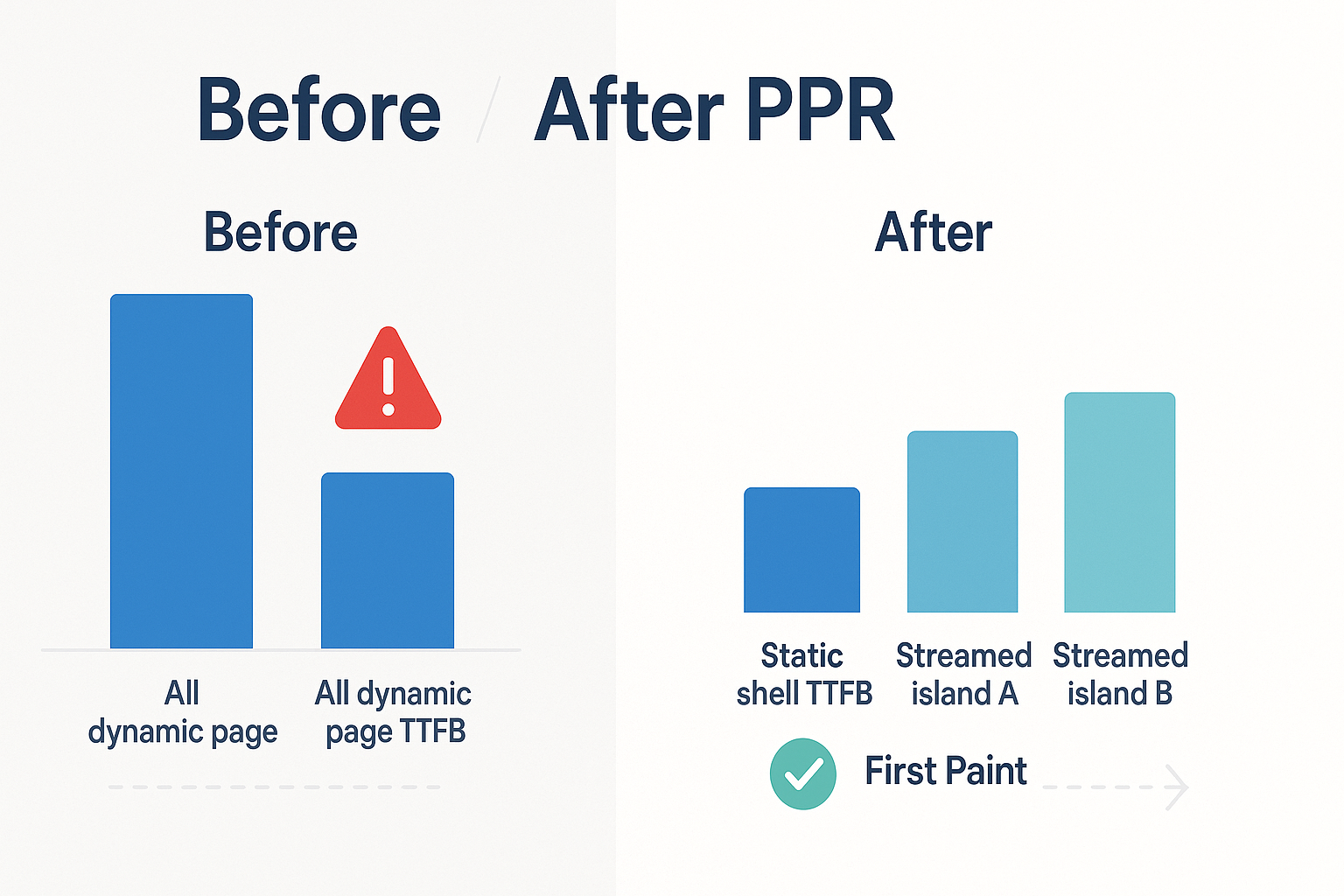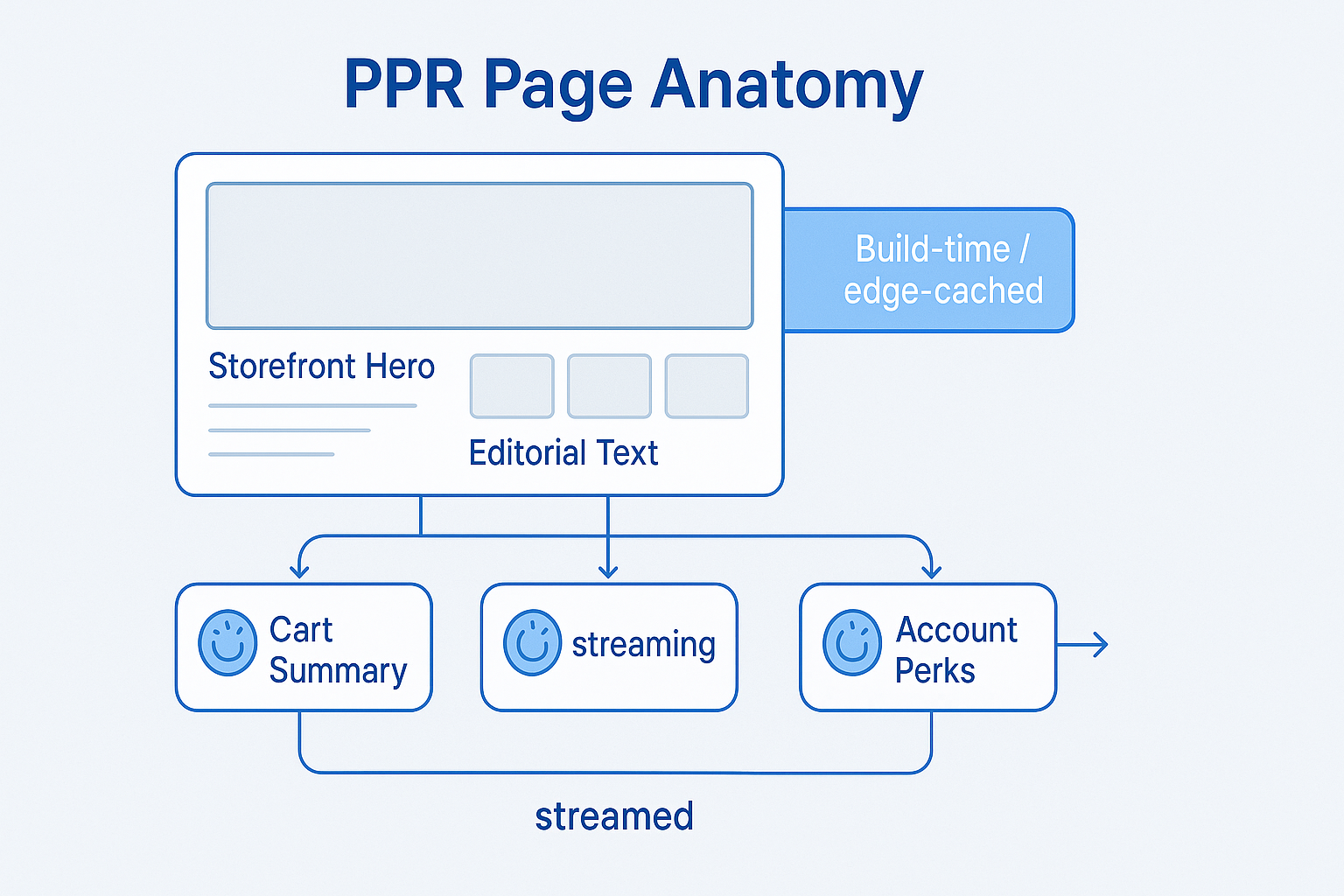When small and mid-sized businesses chase growth in the US market, they usually hit the same wall: every time they add personalization, A/B testing, or logged-in features, pages get slower and conversion dips. Next.js 16 changes the trade-off. With Partial Pre-Rendering, you can treat one page as both static and dynamic at the same time. The stable sections of a page are compiled to fast, cacheable HTML, while the parts that depend on cookies, headers, or per-user data stream in later through React Suspense boundaries. In practice, that means shoppers see your hero, copy, and product grid immediately, while tailored pricing, cart count, geotargeted shipping info, or loyalty tiers hydrate in the next beat. The user’s first impression is fast. The revenue-driving details still feel personal. And your Core Web Vitals stop fighting your CRM.
Why Next.js 16 matters for growth-stage websites
In the US, paid traffic is expensive and attention is short. The moment a page loads, the visitor subconsciously measures whether the experience feels instant and trustworthy. Historically, teams solved this with static generation and aggressive CDN caching, but the moment you read cookies to personalize a banner or compute a price with a promo, the entire route often went “dynamic.” That forced the server to rebuild the whole page for every request, pushed TTFB up, and erased the gains of image optimization and caching. Next.js 16 allows you to split that responsibility inside a single route. Static sections are still compiled ahead of time and delivered from a CDN. Dynamic sections are defined as islands enclosed in Suspense, and they stream in without blocking the first paint. The framework’s routing, caching, and React Server Components pipeline coordinate the choreography so that the user perceives an immediate page while your business logic completes. For small and mid-businesses, the impact is straightforward: launch richer personalization without paying the traditional performance tax, maintain search visibility with consistent HTML for the static shell, and keep your hosting plan predictable because most of the route is still cache-friendly.
This shift also lowers operational risk. Instead of flipping an entire page from static to dynamic when marketing wants to test a headline per region, you isolate just the component that needs request-time context. The rest of the page remains safely prebuilt and versioned. Rollbacks are simpler because your “static shell” rarely changes between tests. Content editors get stable preview links that reflect the real above-the-fold, and engineers focus on well-bounded dynamic islands rather than sprawling, monolithic pages.
How Partial Pre-Rendering works in plain English
Think of a product listing page that always shows the same hero, editorial intro, and a server-rendered grid from your catalog API. None of that needs per-request state; it’s perfect for pre-rendering. Now add three dynamic requirements: a personalized welcome line based on a cookie, a shipping banner that depends on the visitor’s ZIP code header, and a mini-cart count read from a session. With Partial Pre-Rendering, the page returns immediately with the static HTML for hero, intro, and grid. In the places where personalization belongs, you render Suspense boundaries with fast placeholders. As soon as the server resolves each dynamic island, React streams the finished HTML into the open connection, and the client replaces the placeholders without reloading the page. The crucial detail is that reading cookies or headers inside those islands no longer “poisons” the whole route into a dynamic page; the dynamic scope remains local to the island.
Here is a simplified sketch that captures the mechanics without tying you to a specific stack decision. The page is still a server component, but only the islands that actually inspect cookies or headers run per request. Everything else compiles and caches like before.
// app/(storefront)/page.tsx
import { Suspense } from 'react';
import ProductGrid from './ProductGrid'; // server component with cached fetch
import { PersonalizedHello } from './_islands/PersonalizedHello';
import { ShippingETA } from './_islands/ShippingETA';
import { MiniCart } from './_islands/MiniCart';
export default async function Storefront() {
return (
<>
<section>
<h1>Fall Drop</h1>
<p>New arrivals crafted to last.</p>
</section>
<ProductGrid />
<Suspense fallback={<p>Loading your perks…</p>}>
{/* Reads a cookie → dynamic only within this boundary */}
<PersonalizedHello />
</Suspense>
<Suspense fallback={<p>Checking delivery options…</p>}>
{/* Reads a header → dynamic only within this boundary */}
<ShippingETA />
</Suspense>
<Suspense fallback={<p>Cart updating…</p>}>
{/* Reads session state → dynamic only within this boundary */}
<MiniCart />
</Suspense>
</>
);
}Inside an island, you can safely read request context without turning the entire route dynamic. This example keeps fetches explicit about caching so your intent is clear. Data that never changes can be revalidated on a timer, while truly per-user data opts out of caching. The key is that the static shell remains fast and CDN-friendly.
// app/(storefront)/_islands/PersonalizedHello.tsx
import { cookies } from 'next/headers';
export async function PersonalizedHello() {
const name = cookies().get('first_name')?.value;
return <p>{name ? `Welcome back, ${name}!` : 'Welcome to our store.'}</p>;
}
// app/(storefront)/ProductGrid.tsx
export default async function ProductGrid() {
const res = await fetch('https://api.example.com/products', {
// Revalidate every 60 seconds; stays static between revalidations
next: { revalidate: 60 },
});
const products = await res.json();
return (
<div>
{products.map((p: any) => (
<article key={p.id}>
<h2>{p.title}</h2>
<p>{p.price}</p>
</article>
))}
</div>
);
}For SEO, search engines still receive a complete, meaningful HTML document at the first response because your hero, headings, and product summaries are part of the static shell. For UX, the dynamic islands stream in quickly and progressively enhance the page without layout jank. For observability, you can measure island-level timings to learn which personalized elements are carrying their weight and which should be cached or redesigned.
From “all dynamic” templates to PPR without a rewrite
Most teams we meet at Vadimages have one of two architectures: fully static pages with client-side personalization sprinkled after hydration, or fully dynamic server-rendered routes that read from cookies, sessions, and third-party APIs every time. The first pattern often delays the most important content until hydration, harming Largest Contentful Paint and discoverability. The second makes everything fast to iterate but slow to deliver. Migrating to Partial Pre-Rendering aligns those extremes around a single page. The practical process looks like separating your route into a static backbone and a set of dynamic islands, then enforcing explicit caching at the fetch call site.
In code reviews, we start by identifying any read of cookies() or headers() high up in the tree and pushing it down into a dedicated island. If your legacy page computes user segments at the top level, we carve that logic into a server component nested behind a Suspense boundary. Next, we label data dependencies with next: { revalidate: n } or cache: ‘no-store’ so the framework understands what can be pre-rendered and what must stream. When a piece of personalization also drives initial layout, we design a graceful placeholder that preserves dimensions to avoid layout shifts. For commerce, a common pattern is to render a generic shipping badge statically and replace only the numeric ETA dynamically. For account pages, we return the whole navigation and headings statically and stream in order history and saved items in parallel islands, which means the user can begin interacting with tabs while data flows in.
Edge runtime support adds another performance tool. If a dynamic island is cheap and depends only on headers or a signed cookie, running it at the edge keeps latency minimal in large geographies like the US. Heavier islands that call inventory or ERP systems stay on the server close to those data sources. Because the static shell is universal, you can make these placement decisions independently per island without restructuring the route. That flexibility becomes critical when you scale promotions nationally, add regional pricing, or localize to additional states and metro areas.
The other migration concern is governance. PPR does not magically prevent performance regressions if every island turns into a mini-page with blocking logic. We put guardrails in CI that fail pull requests when a top-level component begins using request-time APIs, and we track island counts and waterfall timings in your APM. Business teams get a dashboard in plain language: which personalizations actually lift conversion and which islands burn time without ROI. That alignment lets you say yes to marketing while protecting Core Web Vitals.
What this means for revenue—and how Vadimages implements it
The payoff from Partial Pre-Rendering is not just a better Lighthouse score. It is a calmer funnel where visitors experience a site that looks and feels instant while still speaking directly to them. Launch pages that keep above-the-fold immutable and optimized, while pricing, tax hints, or loyalty prompts quietly appear once you know who the visitor is. Keep your ad landing pages cacheable at the CDN edge for bursts of paid traffic, and still honor geo-sensitive offers or first-purchase incentives in a streamed island. Scale content operations because content teams can change headlines and media in the static shell without worrying that they are touching the same code paths as session logic. And reduce hosting surprises because the majority of requests hit cached HTML and assets; only small islands compute on demand.
Vadimages has been helping growth-stage and mid-market US businesses adopt this architecture without drama. We begin with a short discovery focused on your current routes, data sources, and conversion goals. We map your top-traffic pages into a static backbone and a set of islands, then deliver a pilot that proves two things at once: a measurable improvement in LCP and a measurable lift in a personalization KPI such as add-to-cart rate. From there we scale the pattern across your catalog, editorial, and account pages, with a staging plan that never blocks your marketing calendar. Because our team ships in Next.js every week, we bring ready-made patterns for commerce, SaaS onboarding, and lead-gen forms, including analytics that mark island render times and correlate them with bounce and conversion. If you need integration with Shopify, headless CMS, custom ERPs, or identity providers, we have production playbooks. If you simply want your site to feel as fast as it looks, we can deliver that in weeks, not quarters.

If you are evaluating a redesign, running an RFP, or just trying to bend your ad CAC back down, this is the moment to adopt the rendering model that matches how users actually experience the web. We will audit a key route, deliver a PPR pilot, and hand you a roadmap with performance budgets, caching policy, and a migration checklist your team can own. Or we can own it end-to-end while your in-house team focuses on product. Either way, you will get a site that is both fast and personal—and that wins the micro-moments that make up a sale.
Hire Vadimages to implement Next.js 16 with Partial Pre-Rendering on your site. Our US-focused team delivers storefronts, SaaS apps, and lead-gen sites that pair Core Web Vitals excellence with meaningful personalization. We offer fixed-price pilots, transparent reporting, and direct senior-engineer access. Reach out today and we will propose a PPR rollout tailored to your current stack, your marketing calendar, and the KPIs that pay the bills.

Leave a Reply
You must be logged in to post a comment.